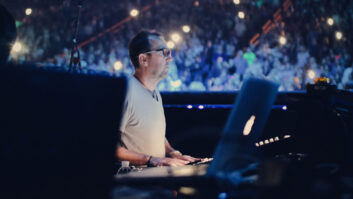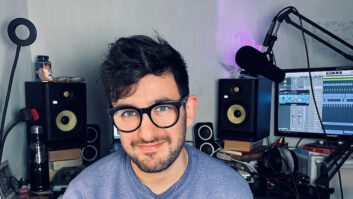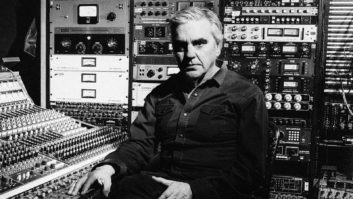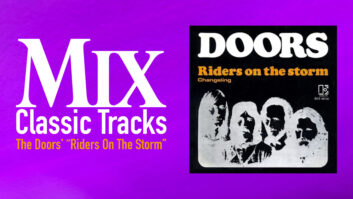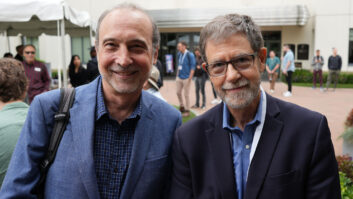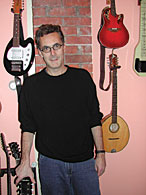
Making a living in the music industry today is a) easy! b) easy, butonly if you know Paris Hilton, c) tougher than ever, or d) forget it.Many talented musicians have thrown in the towel and reclaimed theiramateur status due to the depressed state of the recording andadvertising industries.
Jim Chapdelaine isn’t one of them. The multitalentedguitarist/producer/engineer, who grew up in Connecticut and lives justdown the road from Mark Twain’s home in West Hartford, has just turnedthe corner on one of his busiest years.
Highlights for 2003 included producing Phoebe Snow’s 2002 CD,Natural Wonder, mastering Clarence Clemons’ Temple of Soul:Live in Asbury Park (with performances by Bruce Springsteen) andscoring Energy, a five-part PBS series featuring Ed Asner. Hisown band, Feathermerchants, recorded their new album for Rykodisc, withChuck Leavell on keyboards. A meeting with Artemis Records to discusshis latest project, Backroads for Tomorrow, is scheduled.“Backroads for Tomorrow is a two-man group that I’d describe asColdplay meets Nick Drake,” Chapdelaine says. “They recordbasic tracks in a cabin in Maine and bring them here. I’m playing lapsteel and mandolin on this record, and then we’ll add some horns andkeyboards.”
Chapdelaine spent a few years at Berklee in the mid-’70s and thenleft to study privately with Pat Metheny. While deciding whether toreturn for his degree or go on the road, he received some bad news.“I got cancer and things looked bleak for a while. But I’mhealthy and happy, a husband and the proud father of a 4-year-oldgirl.”
After his recovery, Chap hit the road, playing with “everyonefrom Duff McKagan [Guns N’ Roses] to Mike Love [the Beach Boys] to BigAl Anderson to Les Paul.” By the early ’80s, he was writing andproducing jingles in the Hartford area. “I built a 16-trackstudio and started educating myself about microphones, preamps —the whole shooting match,” he says.
In 2002, Chapdelaine built his latest studio, with the help ofindustry veteran Chris Huston. “Anyone who isn’t familiar withhis history should check out www.chrishuston.com,” he says. “He grewup with John Lennon, engineered the first two Led Zeppelin records anddid a great job for me!”
After selling his digital console last year, Chapdelaine now mixesin Pro Tools, where his path leads from the DAW to outboard gear (viainserts) and into a Dangerous Music 2Bus. Monitoring is done throughthe Dangerous Monitor. “Everyone addresses the front end,”he says. “You need great mics, mic pre’s and equalizers. I neverstop shopping for this stuff. Fortunately, I have lots of guitarendorsements, so I’m able to stay current with Gibsons, for example,without busting the bank. Rick Turner builds great instruments; hemakes all of the weird stuff I love, including an electric mandocelloand baritone 12-string.
“But people are less conscious of the back end. I go in andout of my system using a combination of Apogee Trac2s and 8000SEs, andI’m getting ready to beta test Apogee’s latest converters. I listen onADAM S3A monitors in stereo; I still haven’t gotten much call forsurround work. The Dangerous 2Bus lets me re-access all my cool analogoutboard gear: Manley SLAM!, Focusrite Blue 230, Distressors. I busanalog signals from the converters in subgroups.
“I create the subgroups — overheads, let’s say —in Pro Tools. The 2Bus can be set up as 16 discrete mono channels oreight stereo pairs. If I want to process the overheads, I’ll pick themup at the patchbay before they get to the 2Bus and then route them backinto it. Other parts will pass directly into the 2Bus.
“I love plug-ins and have billions of them, but I can’timagine giving up my analog processors. Once I complete my stereo mix,I’ll go outside once more before I reach my final media, usually anAlesis MasterLink, and hit it with a bit of compression from a ManleyVariMu or the Manley Massive Passive. I have the entire Dangeroussystem: the 2Bus, the Monitor, a headphone amp, a digital/analogmetering device and a little 8-channel line mixer.”
He may have stayed in Connecticut and taken the road less traveled,but the word on Chapdelaine has gotten around. Sterling Sound’s GregCalbi has been watching him for some time. “Jim’s thequintessential post-modern industry figure: a recording engineer,producer, musician, technician and computer wizard,” Calbi says.“You have to be a generalist in this economy, and he has all theelements to be self-contained. Jim has one of the best creativeattitudes I’ve ever come across.”
Given all of his talents, which part of music-making givesChapdelaine the greatest pleasure? “I think producing, in the wayI get to work. You surround a band with a sound. For me, that meansplaying my crazy instruments, thinking about what will make the artistand song shine and working the technology. What a blast!”
Gary Eskow is a contributing editor to Mix.

